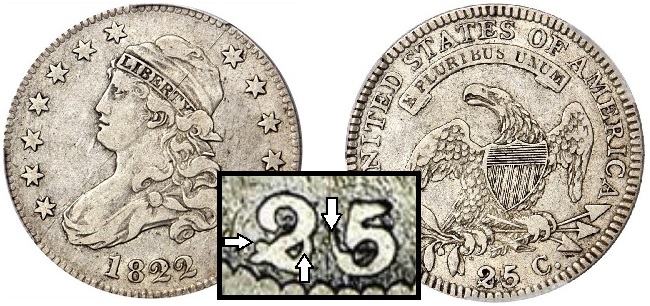1822 Capped Bust Quarter, 25 over 50 C
The Capped Bust quarter first appeared in 1815, carrying a design very similar to the half dollar and dime, both in production since 1807 and 1809, respectively. Capped Bust quarters were minted until 1838, though not continuously.
For a relatively short lifespan lasting just 23 years, there are numerous rarities within the Capped Bust quarter series that have captured the intrigue of collectors for generations. One of them is the 1822 25/50C error variety.
In one of the most famous goofs in United States coining history, the engraver apparently thought he was working on a half dollar reverse die and punched the denomination 50C. At some point someone noticed it was actually a quarter die, and the numerals 25 were then overpunched, with insufficient effort given to eradicate the mistaken 50.(1)
The blunderer has often been suspected to be Mint Engraver Robert Scot, who first plied his trade at the Mint in 1794, but developed poor eyesight after many years of duty. He passed away in 1823 at the age of 78.(2)
Fascinating Fact: The 25/50 flubbed die was not discarded. In 1828 it was pulled out of storage and additional quarters were struck that year (the 1828 25/50C) with the same blundered reverse.(3) Retaining this erred die for service tells us how difficult sinking a die was for the first United States Mint.(4)
The 1822 25/50C Capped Bust quarter is a highly prized coin as one of the most spectacular and odd error varieties in U.S. numismatics. It is aggressively pursued by a broad spectrum of collectors, not simply just early quarter specialists, for its rarity and distinctive character.
Value trends for the 1822 25/50C quarter are some of the steepest anyone has seen over the past 30+ years. For that, Robert Scot’s failing eyesight deserves some of the credit!
| Estimated survivors in all grades: 42 ?
The survivor estimate from PCGS represents an average of one or more experts' opinions as to how many examples survive of a particular coin in all grades. Survival estimates include coins that are raw, certified by PCGS, and certified by other grading services. Learn more at PCGS. |
| PCGS Rarity Scale: 8.6 ?
The 'PCGS CoinFacts Rarity Scale' assesses the relative rarity of all U.S. coins, based on estimated surviving examples. The scale runs from 1.0 to 10.0. The higher the number, the rarer the coin.
Learn more at PCGS. |
| Click HERE to check for availability on eBay** |
Preview of eBay selection (You might have better luck finding this rarity with the HERE link above):
 |
|
| Trendline Avg = 27.97 | BETTER |
Historic Value Trend Charts:
| Last updated 4-8-25 | Return to Key Date Coin List | |
| Compare to Common Date Coin of Same Type | ||
|
|
||
| Download Charts to Your Computer | ||
Sources
1. PCGS. Capped Bust Quarter.
2. Heritage Auctions. 1822 25C 25 Over 50C. Oct 2014 Auction.
3. Stack's Bowers Galleries. 1822 Capped Bust Quarter 25/50C. Feb 2014 Auction.
4. Stack's Bowers Galleries. 1822 Capped Bust Quarter 25/50C. May 2015 Auction.
**Many very fine coin dealers sell on eBay. At any point in time, there may be over one million search results for United States coins. This includes quite a few of the recommendations on our Key Date Coin List.
If you’re thinking about purchasing a rare coin, eBay is certainly worth a look. For your convenience, the links from this site to eBay are coded to bring up only coins certified by PCGS and NGC.
As is always, always the case, never buy a valuable coin from a seller whose trustworthiness cannot be verified. Learn more about this at our chapter Best Places to Buy Coins, which also has a section on doing business on eBay.
In the interest of full disclosure, Rare Coins 101 receives a small commission anytime someone connects to eBay from this site and purchases something.
Coin Images by Stack's Bowers Galleries.


